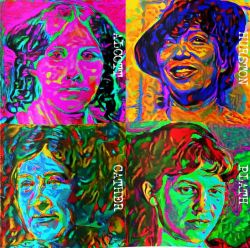The women’s liberation movement during the 1960’s propelled feminist intellectualism which brought us wonderful modern women writers, such as J.K. Rowling, Hilary Mantel, Ursula K. Le Guin and Margaret Atwood. The boys’ club definitely was broken, and is even more apparent when looking back! Critic Sarah Weinman, argues in an essay published by the Library of America that the rise in the 1950s, of the mass-market paperback, brought about a kind of publishing-industry segregation: “Male authors went to the paperbacks, the quick advance, and the gigantic print runs, which were marketed to a predominantly male audience who viewed books as disposable. With rare exception, female authors kept to hardcovers, their books geared to libraries and book-of-the-month clubs with smaller print runs.”
Historically, and may I add quite incorrectly, from Aristotle to Boccaccio, the prevailing misogyny message on the female condition was that “women are morally wicked and intellectually inferior”. Aristotle philosophized that the masculine element brought life to an inert, passive female element. Boccaccio’s disappointments in love caused a change in his writing style which resulted in the Italian literary work, Il Corbaccio, or The Crow. The protagonist tells the story of his unreturned love of a widow and his love to the spirit, who warns him against women who with their lust and “female wickedness” endanger men.
In Japan, prior to the Heian era, (794-1185), there was no native written tradition. The male educated elite wrote in Chinese, while women were forbidden to write in the Chinese language. Heian women developed Hiragana, a cursive syllabary with a distinct writing method that was uniquely Japanese, and thus gave written expression to the spoken word. Three late 10th and early 11th -century women presented their views of life and romance at the Heian court in the books: Kagerō Nikki, by the author “the mother of Fujiwara Michitsuna”, (Her true name is unknown), The Pillow Book, by Sei Shōnagon and The Tale of Genji by Murasaki Shikibu.
Persuasion, which was published in 1818, after Jane Austen’s death, revealed her true feelings about gender inequality, and articulates and criticizes late 18th century English views of courtship and marriage. The novel’s moral, seems to be, that young people should always marry according to their own inclinations and upon their own judgment. Central to Jane Austen’s book is a longing for civility in an age of coarseness, meanness and cruelty against women. The hardness of life for a woman was laid bare. The feelings and experiences of the novel’s central character, Anne Elliot, were understood and shared by the women of her time and beyond.
Patriarchy prompted the dissatisfaction which was common among young women in the early 19th century. In the fall of 1847, Emily Dickinson entered Mount Holyoke Female Seminary, which, under the guidance of Mary Lyon, the school was known for its religious predilection. Emily’s stay at Mount Holyoke was for a single year; a decision she attributed to her father, but said nothing further about his reasoning. Edward Dickinson’s reputation as a domineering individual in private and public affairs suggests that his decision may have stemmed from his desire to keep his daughter at home. When well-known writer of the time, Thomas Wentworth Higginson, invited Emily Dickinson to an event in Boston, she declined with a phrase that, (like many sentences in her letters), falls into the rhythm of her poetry: “I do not cross my Father’s ground for any House or town.”
Up until recent years, women authors geared towards the genre of romance and steered away from the sanguinary genre, comics and graphic novels, which skewed heavily toward young men, with emphasis on superheroes, fantasy and science fiction. Lately, women authors’ success in these predominately male audience genres, underscores how much the audience has broadened, and how very capable women are to excel in all genre! Graphic-novel sales are outpacing the overall trade-book market, and their audience has expanded to include more women and younger readers. Women are too realistic to romanticize violent worlds in which they are, far more often than not, the victims. Small wonder that when authors such as Dolores Hitchens, Dorothy Hughes, Vera Caspary, Patricia Highsmith, Charlotte Armstrong, Elizabeth Sanxay Holding, turned to writing crime novels and themes of violence, they focused instead on marrow-shriveling terror.
Margaret Atwood’s dystopian novel, The Handmaid’s Tale, which focuses on forced breeding programs and female enslavement, hit close to home on the struggles women have been confronting throughout history. The book’s theme centers on an alliance between radical feminists and religious fanatics who aim to control the women and the population in the fictional republic of Gilead.
The far fewer than men, successful women authors in existence, should be every rare book collector’s pursuit. The scarcity created due to some of the factors outlined here, are hopefully a thing of the past. Since its inception at the beginning of last century, the controversial Nobel Prize in Literature was awarded to no more than 5 women, prior to the women’s liberation movement of the 1960 and 70’s. The number has more than tripled since then at an accelerated rate. Still, rare books by women authors are becoming scarcer.

{ 1 comment… read it below or add one }
Such an excellent article! Thank you for sharing! I’d love to hear your take on Sylvia Plath (also a 1960’s literary heroine) as well as Toni Morrison (although ten years after, with The Bluest Eye being written in the 70’s). This article is so relevant to our time and in perfect pre-context to the new film “Dickinson” coming out soon.